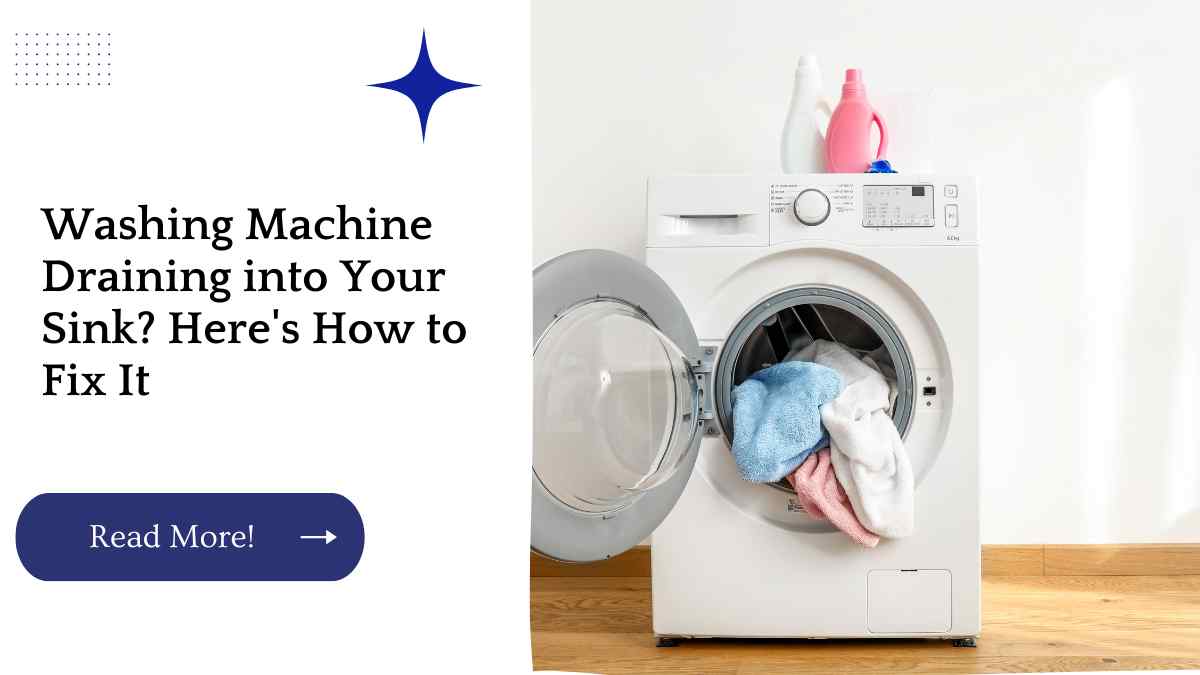If you’re experiencing the issue of your washing machine draining into your sink, you’re not alone. This can be a frustrating problem to deal with, but thankfully there are ways to fix it. In this article, we will discuss the causes of this issue and provide step-by-step instructions on how to fix it.
| Key Takeaways |
|---|
| Understanding the causes of the problem is crucial to fixing it. |
| Checking the drainage pipes, sink P-trap, and washing machine drain hose can help resolve the issue. |
| Regular maintenance and proper usage of the washing machine can prevent future problems. |
| Call a professional if there are plumbing or electrical issues. |
Understanding the Problem: Why is Your Washing Machine Draining into Your Sink?
Before we can fix the issue, it’s important to understand what’s causing it. There are several reasons why your washing machine might be draining into your sink:
Clogged Drainage Pipes
One of the most common causes of this problem is clogged drainage pipes. If the drainage pipes in your home are clogged, water from your washing machine might flow back into your sink instead of draining out properly.
Faulty Sink P-Trap
The P-trap is a U-shaped pipe under your sink that’s designed to prevent sewer gases from entering your home. If the P-trap is faulty or damaged, water from your washing machine might flow back into your sink.
Need help with the plumbing of your washing machine? Check out our comprehensive guide to basement washing machine drain plumbing DIY tips to learn more about fixing common washing machine plumbing problems.
Issues with the Washing Machine Drain Hose
The drain hose is the hose that carries water from your washing machine to the drainage pipes in your home. If there’s a problem with the drain hose, water might flow back into your sink instead of draining out properly.
How to Fix the Problem
Now that we’ve identified the potential causes of the problem, let’s discuss how to fix it.
Check the Drainage Pipes
If the problem is caused by clogged drainage pipes, you’ll need to clear the pipes. You can do this by using a plunger or a drain snake. If the clog is severe, you may need to call a professional plumber to clear the pipes.
Tired of your washing machine draining into your sink? Our guide on how to drain your washing machine outside with these steps will provide you with an effective solution to move the drainage system of your washing machine outside.
Check the Sink P-Trap
To check the sink P-trap, you’ll need to locate the P-trap under your sink. You can do this by looking for the U-shaped pipe under your sink. Once you’ve located the P-trap, check it for any signs of damage or wear and tear. If the P-trap is damaged, you’ll need to replace it.
Check the Washing Machine Drain Hose
To check the drain hose, you’ll need to locate the hose at the back of your washing machine. Make sure that the hose is properly connected and not kinked or damaged. If the hose is damaged, you’ll need to replace it.
Install a Dedicated Washing Machine Drain
If none of the above solutions work, you might need to install a dedicated washing machine drain. This will involve installing a new drainage pipe specifically for your washing machine.
Preventative Measures
Once you’ve fixed the problem, it’s important to take preventative measures to ensure it doesn’t happen again. Here are some tips to keep in mind:
Is there no cold water coming out of your shower? Don’t be puzzled! Head over to our article on how to solve the mystery of no cold water in your shower to learn some easy tricks to fix the problem.
Regular Maintenance
Regular maintenance can go a long way in preventing issues with your washing machine and drainage pipes. Clean your washing machine regularly and check for any signs of wear and tear on the drain hose.
Use of Lint Filters
Lint filters can help prevent lint and other debris from clogging your drainage pipes. Make sure to clean your lint filter after every load of laundry.
Proper Use of Detergents
Using too much detergent can cause suds to build up in your washing machine and drain hose, leading to clogs. Follow the manufacturer’s instructions when using detergent.
Proper Loading of Clothes
Overloading your washing machine can put a strain on the machine and cause issues with the drainage system. Make sure to follow the manufacturer’s guidelines for loading your washing machine.
When to Call a Professional
While many issues with your washing machine and drainage system can be fixed on your own, there are times when it’s best to call a professional plumber or electrician. Here are some signs that it’s time to call in a pro:
Plumbing Issues
If the issue is related to your home’s plumbing system, such as a clogged drainage pipe, it’s best to call a professional plumber.
Nobody wants to take a cold shower, especially in winter. If you’re having trouble with no hot water in your shower, visit our guide on no more cold showers troubleshooting tips to learn how to fix the issue without calling a professional.
Electrical Issues
If the issue is related to the electrical system in your home or washing machine, such as a faulty circuit breaker or wiring issue, it’s best to call a professional electrician.
Conclusion
Experiencing the issue of your washing machine draining into your sink can be frustrating, but there are ways to fix it. By understanding the potential causes of the problem and following the steps outlined in this article, you can get your washing machine draining properly again. Remember to take preventative measures to avoid future issues, and call a professional if needed.
Further Reading
Why Does a Washing Machine Drain Into a Sink? – This article from Home Guides explains the potential causes of washing machine draining into your sink and provides solutions for fixing the problem.
Washing Machine Drains Into Sink: How to Fix It – This guide from Go Full DIY provides step-by-step instructions for fixing the issue of your washing machine draining into your sink.
Why is My Washing Machine Backing Up? – This article from TLC Plumbing explains the potential causes of washing machine backing up and provides tips for fixing the problem.
Looking for an efficient laundry setup? Our guide on washing machine and sink drainage for an efficient laundry setup provides you with useful tips and tricks on how to optimize your laundry room for maximum results.
FAQs
Can I use any type of drain hose for my washing machine?
No, it’s important to use a drain hose that’s specifically designed for washing machines. These hoses are usually made of a durable material that can withstand the pressure of the water and are less likely to kink or crack.
How often should I clean my washing machine?
It’s recommended to clean your washing machine at least once a month to prevent the buildup of dirt, grime, and bacteria.
How do I know if my P-trap is damaged?
You can check your P-trap for any signs of cracks, leaks, or wear and tear. If you notice any issues, it’s best to replace the P-trap.
Can overloading my washing machine cause it to drain into my sink?
Yes, overloading your washing machine can cause strain on the machine and lead to issues with the drainage system.
What should I do if I’ve tried all of the solutions and my washing machine is still draining into my sink?
If none of the solutions outlined in this article work, it’s best to call a professional plumber or electrician to assess the issue and provide a solution.
In Conclusion
Dealing with a washing machine draining into your sink can be frustrating, but it’s important to take action to fix the problem. By understanding the potential causes and following the steps outlined in this article, you can get your washing machine draining properly again. Remember to take preventative measures and call a professional if needed.

Hellen James is the author of the blog and a licensed plumber with over 15 years of experience. She shares her knowledge and experience in plumbing and drainage through insightful and informative articles

